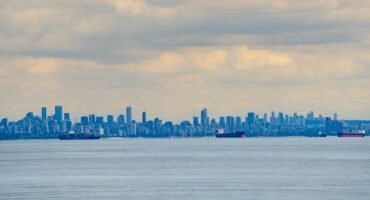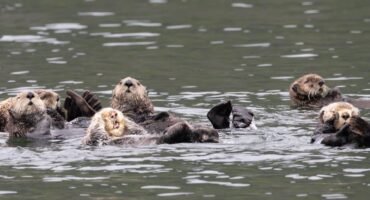
Exploring Malaysian Borneo – Sepilok
This post is part of our wild adventure to Malaysian Borneo. In case you don’t want to read this sequentially, or you are looking for a specific part of the trip, here are some shortcuts:
- Kota Kinabalu
- Sepilok <– You are here
- Kinabatangan
- Lahad Datu
- Danum Valley
The flight from Kota Kinabalu was quick, and before we knew it we were descending into the lush landscape of Sandakan. This is the jumping off point for most Malaysian Borneo adventures.
While waiting for our luggage, we couldn’t help but observe the diverse array of travellers in the baggage area. Some stood out with their full safari gear, relentlessly applying bug repellent and clutching their unmistakable money belts. I remember this feeling from our first trip to Kenya in 2005. We’ve changed a lot since then, and were also too exhausted from three months in Kuala Lumpur to give any f*cks.
Our hotel had arranged a pickup, and we were relieved to see Uncle Rebu waiting for us. It was about a 30 minute drive to Sepilok Forest Edge Resort, where we dropped off our bags and grabbed our cameras. Our goal was to visit the proboscis monkey sanctuary, a short 30-minute drive away. The sanctuary offers four feedings daily, alternating between two platforms. Platform A, closer to the entrance, tends to be less crowded, while Platform B has a cafe and a spacious air-conditioned room featuring a video about the sanctuary. Admission was 60 Malaysian Ringit (MYR) per person, and an additional 10 MYR for a camera pass. This is about $15 USD or $24 AUD
We arrived around 2 pm, and were greeted by proboscis monkeys even before we left the car. We strolled along the elevated boardwalk to reach Platform A, finding ourselves entirely alone.
Proboscis monkeys weigh about 7 to 23 kilograms (15 to 52 pounds) and measure around 60 to 76 centimetres (24 to 30 inches) in size. Here’s an interesting tidbit: these monkeys display sexual dimorphism, meaning males sport those iconic large pendulous noses, while females have much smaller and less conspicuous ones. Unfortunately they are endangered, largely due to habitat loss from deforestation and land development, as well as the threats of hunting and poaching.
At first, we moved cautiously, but it quickly became clear that the monkeys were accustomed to human presence and showed no concern. The rangers provide helpful tips such as, “If monkey comes, don’t run”. As it grew closer to feeding time, more and more monkeys emerged from the forest. The larger males delighted in running through the viewing area and creating a ruckus.




The weather was unbelievably scorching and humid, leaving us with drenched clothes and eyes stinging from the salty sweat. But the photo opportunities here were among the highlights of our trip. Not a single person we met during our travels in Borneo had visited Labuk Bay. I’m guessing the cost of admission (which is about double the orangutan sanctuary) and distance from town may be contributing factors to its popularity.
Upon returning to the lodge, we were assigned to a deluxe chalet named “Tip of Borneo.” The room exceeded our expectations, with a cute fishtrap light, reliable air conditioning, and a rustic outdoor bathroom.



Despite our hopes for wildlife sightings, we didn’t encounter much during our stay, even with the noted hotspots on the map. We ate dinner, spaghetti bolognese with lemongrass and a watermelon margherita, at the lodge’s open air restaurant.

The official start of our Borneo tour had finally arrived. We were picked up by Jimmy after breakfast and driven about five minutes to the orangutan sanctuary.
We were required to wear masks to ensure we didn’t inadvertently transmit germs to our close genetic relatives, the orangutans, whose DNA shares a remarkable 97%-99% similarity with humans. Navigating the 33°C heat and stifling 90% humidity with masks was far from enjoyable, especially in such a crowded place swarming with tour buses. While a couple of orangutans made a brief appearance, the overall experience left much to be desired.



Following our orangutan encounter, we crossed the parking lot to visit the Sun Bears, the smallest bear species. Sadly, their current status is “vulnerable,” signifying a looming threat of extinction in the wild due to habitat loss and poaching for traditional medicine. A few of the bears had visible scars from having their gal bladders removed – some humans are just the worst! The sanctuary offered a less crowded atmosphere compared to the orangutan sanctuary, but the perspective was primarily from elevated boardwalks, reminiscent of a zoo visit rather than a connection with the wild.

Jimmy dropped us off for lunch, which was chicken rice in a stifling hot open air restaurant. This was the meeting point for the four other people who would be transferring to Kinabatangan with us. We were here for a few hours, which seemed like forever due to the heat.
Next Up – Kinabatangan
We’re Andy and Jennifer—two former corporate executives who chose long ago to prioritise experiences over stuff while pursuing our passions for travel and photography. From the Arctic to Antarctica, and most places in between, we’ve captured the world through our lenses and love sharing those stories. Our careers gave us the means, but our purpose is inspiring others to explore and helping people create images they’re proud of.




